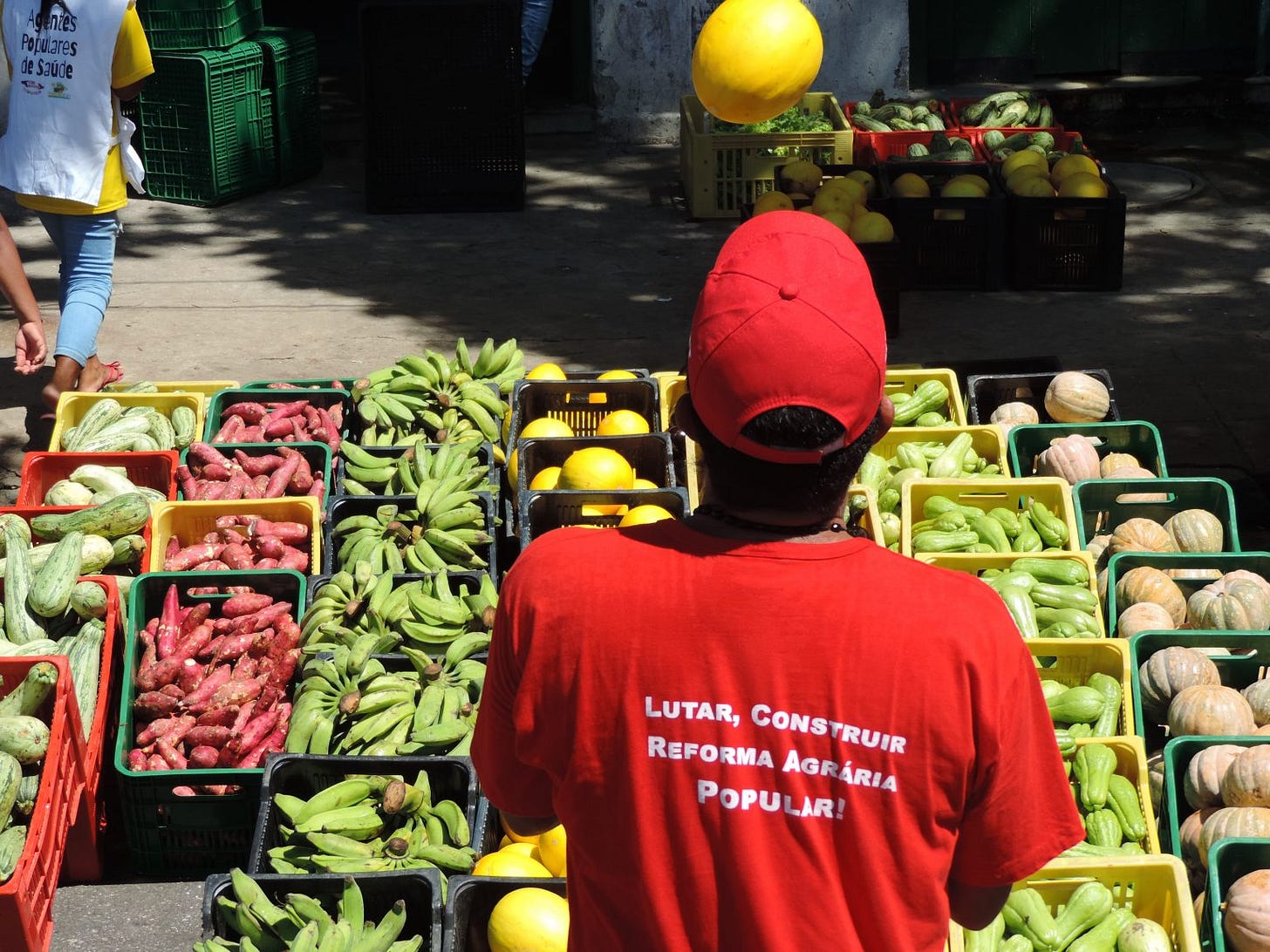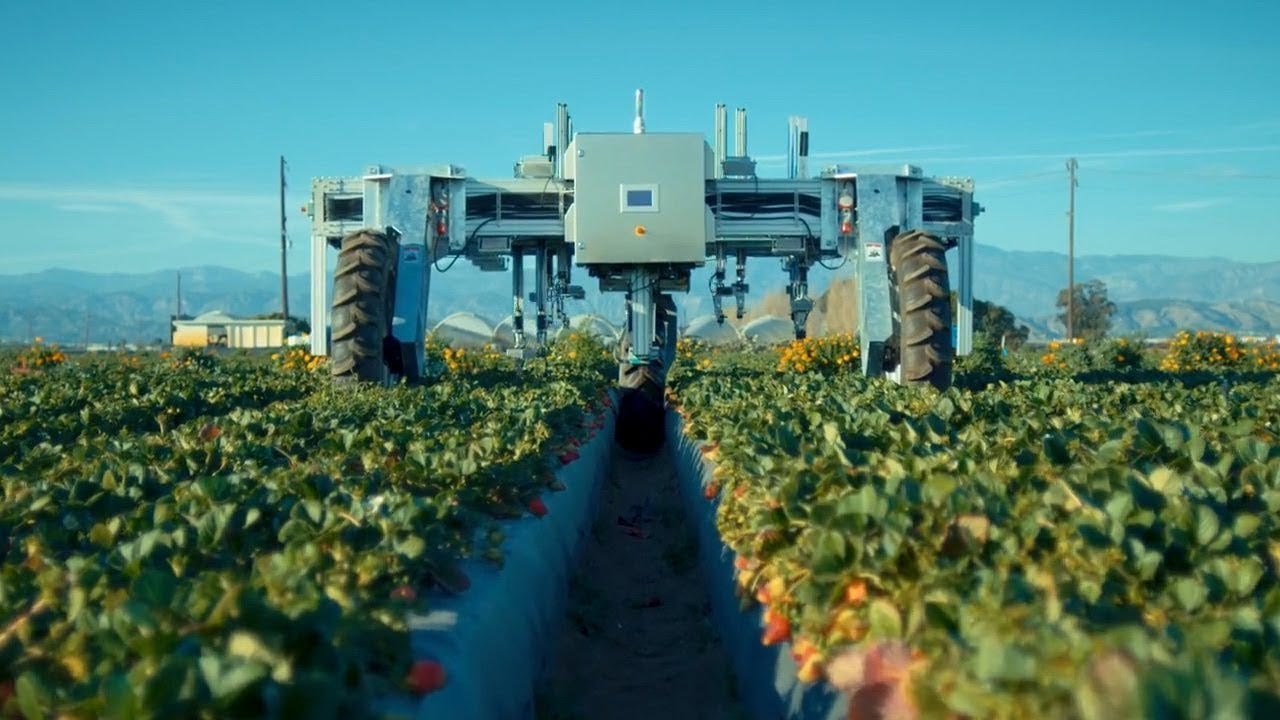Agri-tech is no solution for Brazil's small farmers
Cutting-edge technology cannot substitute for basic land reform
Agriculture is no longer an activity left to the inscrutable power of sun and soil. For many in the sector, agri-tech promises to transform the way farming is conducted in an age of advanced science.
No wonder, then, that the head of Brazil’s Agricultural Research Corporation, Embrapa, is seeking to bring cutting-edge technologies to bear on the country’s small farmers. Touting Embrapa’s reputation as “the Brazilian NASA”, president Silvia Massruhá is eager to see the corporation’s advancements in “biotechnology, nanotechnology, automation, precision agriculture and digital agriculture” reach the owners of Brazil’s 4.4 million family farms.1
Under the second presidential tenure of Lula da Silva, Brazil’s massive agricultural sector is undergoing a sort of technocratic boom. Gone is the image of farmers as archaic and conservative: the watchwords of the new, ‘conscious’ farmer are sustainability and efficiency. From developing low-carbon variants of soya beans to launching carbon credits on Wall Street, Brazil’s agricultural bureaucracies are all-in on the tech train. Surely, here is to be found the solution to the environmental and social backwardness that has long dogged rural Brazil. Here, on the cutting-edge of scientific innovation, is the key to a sustainable, more productive agriculture open both to the nation’s agro-corporations and beleaguered small farmers.
This was a significant theme of the seventh Sustainable Agribusiness seminar hosted this July by Brazil’s biggest newspaper, Folha de São Paulo, and funded in part by the Banco do Brasil.2 The main challenge, as Folha itself puts it: ending the “bottleneck” that hinders the “implementation of these [technological] innovations for small and medium-sized producers.”3 And the obvious solution: more technology.
If Brazil’s massive size makes technology uptake challenging, digital networks and artificial intelligence will bridge the gap. If farmers have trouble feeding tech companies enough data to optimise their land’s productivity, “satellites and sensor images” can do the job for them. Through the cooperation of “Embrapa, private companies, state research agencies, universities and startups,” Massruhá assures us, this raft of technological innovation will reach the humble farmer and herald a new world of sustainable, hyper-productive agriculture.4
But is a dearth of technological innovation really what plagues Brazil’s small farmers? The conclusion is tempting. Outdated technologies, inefficient cropping techniques, and weaker seed variants are problems that present straightforward solutions. Simply develop the technology and implement it widely. The notion seems in perfect sync with wider trends in global agriculture. Since the Green Revolution of the 1960s supercharged farmers’ ability to produce certain cereals with the aid of chemical fertilizers, hardier seed variants, and mechanised planting and harvesting, global agricultural development has taken on a technocratic face. Perhaps the only thing separating a poor farmer from a rich one is their access to disease-identifying apps, real-time commodity prices, and remote sensing technologies.5
But this is a dangerously truncated view of agricultural development. The cause of the crisis of debt and poverty that plagues Brazil’s small farmers is not technological backwardness but a ferociously unequal agricultural system designed to uphold the supremacy of large agro-corporations producing cash crops for export.
Brazil’s small farmers do not need nanotechnology and AI-driven productivity apps. They need land reform. The relegation of 50 percent of Brazil’s farms to just 2 percent of its territory while 3 percent of landowners hoard two-thirds of Brazil’s arable land is a far more salient cause of rural poverty and inefficiency than the absence of technology.6 Brazil’s small farmers do not need automation but an end to their own predation. They need justice upheld in a country where routine violence against landless workers continues to thwart the struggle of the rural poor for survival. The crisis of Brazil’s small farmers is a crisis of patrimonial power.
It is also a food crisis. The production of basis food staples — rice, beans, mandioca — has signally failed to rise with population growth since the 1990s, with the production of mandioca actually falling in absolute terms.7 Poor Brazilians, many of them rural, have suffered worst from the resulting inflation in food prices. The absence of basic home-grown foodstuffs, when combined with the far-right's slashing of federal anti-hunger programs, reduced 33.1 Brazilians to near starvation when the pandemic pummelled the economy in 2020—2022.8 A country boasting some of the world’s biggest agro-corporations was failing to feed its own citizens.
Meanwhile the cultivation of cash crops, foremost among them soybeans and sugarcane, has exploded. Brazil is the world’s largest net exporter of agricultural goods, producing a whopping 35 percent of global soybean supply.9 Needless to say, the expansion of mono-crop cultivation for export has not been fuelled by small farmers but large agro-industrialists. Agribusiness’s growing power has expelled countless small cultivators from the countryside and increased land inequality across the country. It’s thus ironic that Embrapa would tout “low-carbon soya beans” as beneficial to small farmers, who have been among the worst-impacted by the expansion of the soya juggernaut. And no matter how low-carbon the particular bean, the widespread destruction of cerrado [savannah] and Amazon biomes for soyabean production can never be ecologically beneficial.
There is already an impressive, if not mainstream, movement in Brazil seeking to solve the crises of rural poverty and ecological devastation. Indeed, it’s a movement led by small producers themselves. The Movimento Sem Terra, or Landless Movement, is the country’s largest social movement and one of the most significant forces in the long struggle of the Brazilian poor for the rights of citizenship and a dignified life. Here we find an alternate vision of rural transformation — one which, like Lula’s agricultural bureaucrats, aims at supporting small cultivators and averting climate catastrophe. What are its alternate solutions?
Rather than technological upscaling, the MST sees liberation for small farmers coming through agroecology. This vision of agriculture is oriented around the production of diverse, culturally-appropriate food crops rather than mono-crops for export, and employs labour-intensive, organic techniques attuned to the ecologies of local landscapes. It is a system the MST has honed through trial and error, with their current strategy of integrating agricultural cooperatives into the market with high-quality, organic foodstuffs following failed attempts at collectivized agriculture and mechanisation.
Unlike conventional, capital-intensive forms of agriculture — the likes of which Embrapa and its ilk are eager to promote — agroecology is attuned to the material conditions of family farming. Farmers with small, irregular properties can wring far greater productivity per acre with agroecological techniques than conventional mono-cropping, while agroecology’s labour-intensivity does not render farmers redundant with combine harvesters and chemical pesticides. For many small farmers, then, agroecology is nothing less than an ethic that enshrines the dignity and life-ways of the peasant against a world-economy bent on its destruction.
It is also economically profitable. Today the MST is expanding its network of co-ops and outlet grocery stores in major cities such as São Paulo, managing its own brands of organic rice and oils, and courting government contracts to source family-farmed produce for school meals and state food programs. In Rio Grande do Sul, the state where the MST has been longest established, peasant co-ops have become the largest producers of organic rice in Brazil. In the process the MST is gaining new audiences in its struggle for agrarian reform. In bringing its organic produce to cities, the MST is cultivating a market niche, raising its profile with a middle-class base of young, liberal, urban professionals that it’s never before possessed.

This is, to be sure, a far cry from the Landless Movement’s radical roots. No more is the peasant movement that once stormed fazendas brandishing sickles and machetes. As one scholar puts it, the struggle of Brazil’s rural poor for agrarian reform – once considered a critical step in the country becoming a true democracy — has been “reduced today to the management of subalternity of family agriculture in the face of agribusiness.”10 ‘Managed subalternity’ may be the only feasible strategy for small farmers given the overwhelming power of large-scale landowners.11 But it is certainly preferable to landlessness, depredation, and forced exile to urban peripheries — all of which continue to scourge Brazil’s camponeses [peasants].
Agroecology also strikes me as a more reasonable path to economic development and ecological sustainability than the tech-driven strategy promoted by the Lula government. From the small farmer’s point of view, it is not the government’s R&D programs but its credit and subsidies, state procurement programs of peasant-grown food, and land redistribution agencies that really keep family farming alive. While these are policies better-funded under Lula than under the far-right regimes that preceded him — which laid waste to all state supports for small farmers while unleashing a frenzy of unregulated agribusiness expansion — this Workers Party government has few laurels to rest upon.
There are certainly important benefits that small farmers can derive from new technologies when appropriately implemented. Luddites will not inherit the earth. But agri-tech cannot transform an agricultural system that is fundamentally unequal and weighted against small famers. Nor can a wasteful and destructive paradigm of mono-crop production for export ever be technologically upgraded into assuring sustainability and national development.
Since colonial times, Brazil has been integrated into the world-system as a source of natural commodities and cash crops. And since colonial times, the outsized power this has assured landowning and rentier elites has consistently thwarted the country’s attempts to cultivate value-added industry and an inclusive economy. Until this system is plucked up by the roots, no amount of technology will make something better grow in its place.
https://www1.folha.uol.com.br/seminariosfolha/2024/07/implementacao-de-tecnologias-agricolas-para-pequenos-produtores-ainda-e-gargalo-a-ser-superado.shtml; https://news.mongabay.com/2019/01/as-brazilian-agribusiness-booms-family-farms-feed-the-nation/
https://www1.folha.uol.com.br/seminariosfolha/2024/07/folha-promove-seminario-sobre-agronegocio-sustentavel.shtml
https://www1.folha.uol.com.br/seminariosfolha/2024/07/implementacao-de-tecnologias-agricolas-para-pequenos-produtores-ainda-e-gargalo-a-ser-superado.shtml
https://www1.folha.uol.com.br/seminariosfolha/2024/07/implementacao-de-tecnologias-agricolas-para-pequenos-produtores-ainda-e-gargalo-a-ser-superado.shtml
https://www.weforum.org/agenda/2021/10/agri-tech-digital-tools-boost-crops-farmers-africa/
Luís Pinto et al., “Quem São os Poucos Donos das Terras Agrícolas no Brasil - O Mapa da Desigualidade,” Sustenabilidade em Debate, no. 10 (2020).
Alentejano, “Políticas do governo Bolsonaro sobre o campo.”
To quote my dissertation The Politics of Hunger: “By 2020’s end, a national survey conducted by respected NGOs found that 55 percent of Brazilian households were experiencing food insecurity, and 9 percent enduring actual hunger [conviviam com a fome]. By 2022, conditions had deteriorated further and 15.5 percent of the country’s households—some 33.1 million people—had little or nothing to eat. Less than 42 percent of households were actually food secure in 2022: across the country 125.2 million Brazilians were suffering from some level of food insecurity from insufficient diets to outright hunger.” Source: Rede PENSSAN, Insegurança e Covid-19 no Brasil.
https://www.fao.org/faostat/en/#data/QCL
De Farias, “Ascensão do ‘agronegócio’ e crise da democracia no Brasil,” 101, 102
The agribusiness lobby is currently the largest in Brazil’s Congress.





